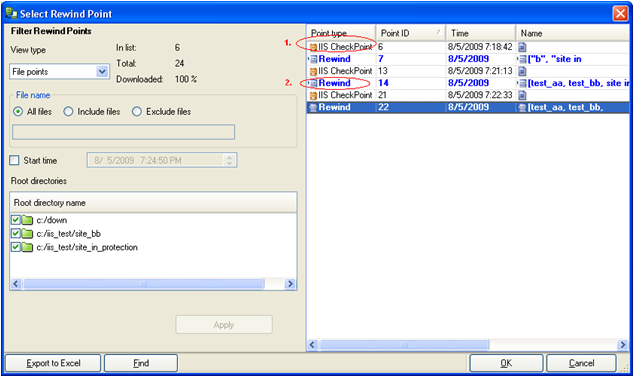The Data Rewind recovery method lets you rewind data to a point in time before it was corrupted. The rewind process takes place on the Replica server before the reverse synchronization process starts. The Data Rewind method uses rewind points or bookmarks that enable you to reset the current data to a previous state.
You can use this option only if you set the Data Rewind option under the Recovery property to On.
If you set this option is Off, CA ARCserve RHA will not register data rewind points. For more information about Data Rewind parameters (Retention Period, Max Disk Size), see the Administration Guide.
Note: The automatic registration of the rewind points starts only after the synchronization process is completed, and the message, "All modifications during synchronization period are replicated" appears on the Event pane. Similarly, you cannot manually set bookmarks during synchronization. In the following example, a File Server scenario is used, but the steps are the same for all scenario types.
Important! The data rewind process operates in only one way‑there is no replay forward. After rewind, all data subsequent to the rewind point will be lost, since data after the rewind point will be overwritten with new data.
To recover lost data using rewind points
Note: If multiple Replica servers participate in the required scenario, select the Replica from which you want to recover data.
The Recovery Method page of the Restore Data Wizard opens.
Notes:
After you select a rewind data option, a recovery scenario is automatically created. This recovery scenario will run until the end of the rewind process.
The Rewind Point Selection window appears.
The Select Rewind Point dialog opens.

The Select Rewind Point dialog displays a list of all rewind points for IIS. These include modifications of folders and files that CA ARCserve RHA registered automatically and the bookmarks that you have defined.
You can filter the list according to the rewind point type or other criteria, using the Filter Rewind Points pane on the left.
Note: If you want to use a Bookmark as the rewind point, it is best practice to select the closest rewind point that indicates an actual event.
The Rewind Point Selection window appears, with information about the rewind point you selected.
The Synchronization Method window appears.
Note: If the user credentials you used to log in to the Manager are different than the ones required for working with the Engine on the Replica, a User credentials dialog opens, asking you to enter log on account details for the selected Replica.
CA ARCserve RHA rewinds the data to the point you selected. After the rewind process ends, you receive the message, "Rewind process is completed successfully" in the Event pane.
If you chose to replace the data on the Master with the data on the Replica, CA ARCserve RHA starts the synchronization process from the Replica to the Master. When the process ends, the temporary recovery scenario is stopped and then deleted.
The Synchronization Report is generated.
Now, the replication process can restart on the original scenario.
| Copyright © 2012 CA. All rights reserved. | Tell Technical Publications how we can improve this information |